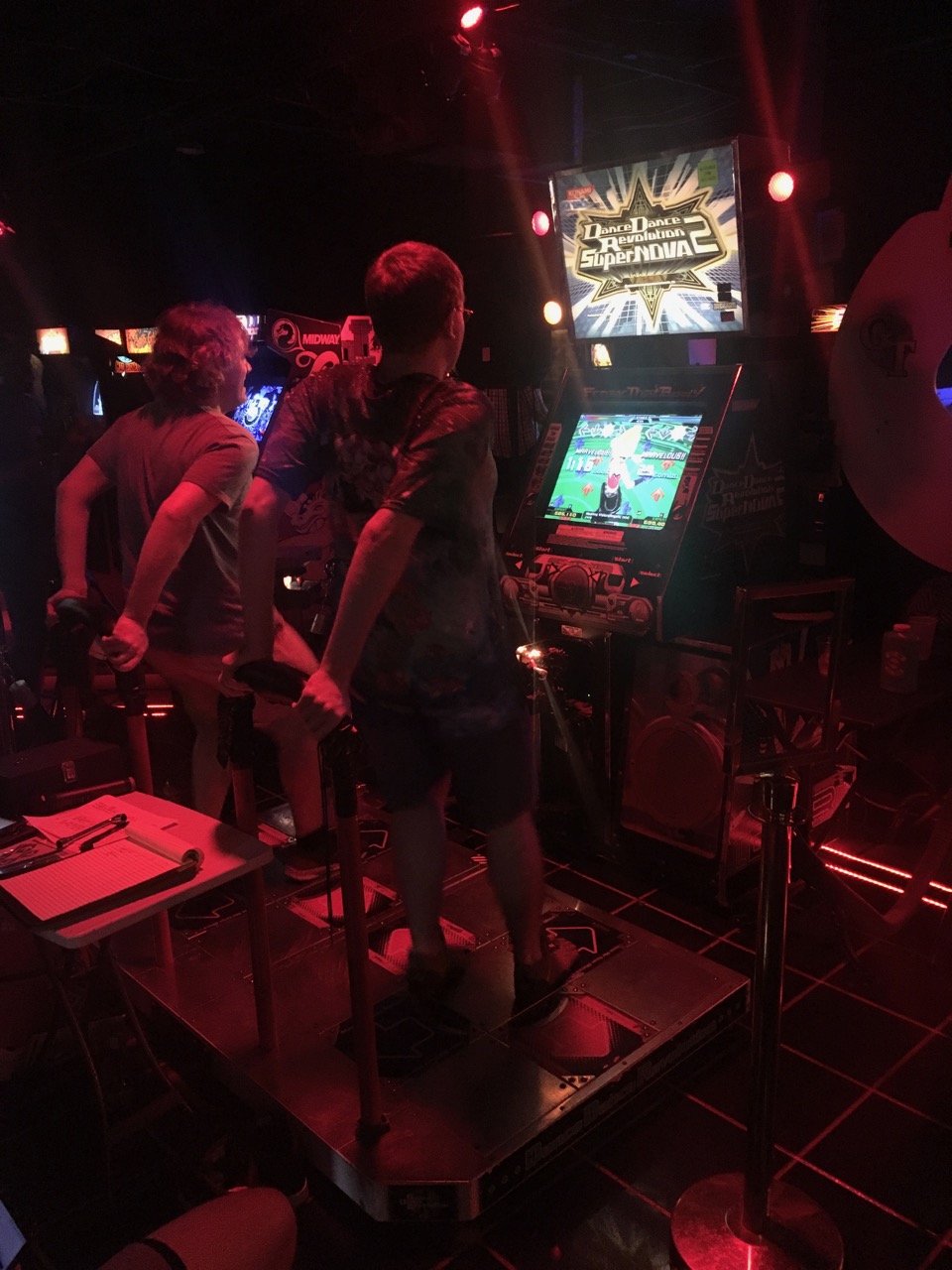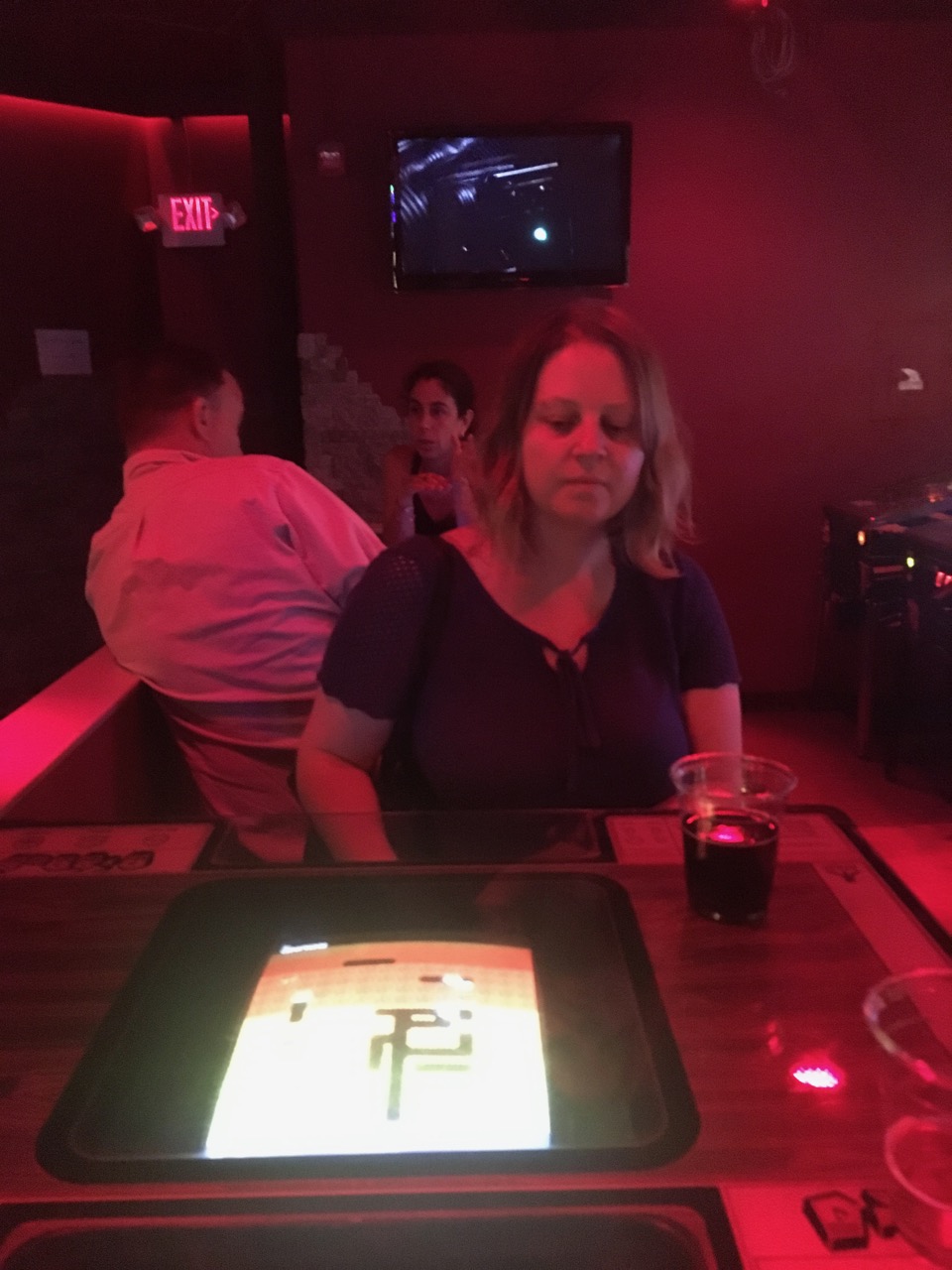You have just read a blog post written by Jason McIntosh.
If you wish, you can visit the rest of the blog, or subscribe to it via RSS. You can also find Jason on Twitter, or send him an email.
Thank you kindly for your time and attention today.
Providence’s Free Play Bar Arcade, curled around a knot of nightclubs within a murky block behind the city’s Performing Arts Center, has created one of the finest implementations of a classic-games-focused video arcade — with or without an alcoholic component — that I’ve had the pleasure to visit in person.

Its name evokes its unusual business model: for a flat cover charge of ten dollars (or five dollars on nights preceding weekdays), you have the run of the place, with all the normally coin-operated machines set to free-play mode. Of course the arcade encourages you to supplement your visit through a visit to its full bar, but it doesn’t press the issue. Indeed, it will almost certainly take you quite a while to even see the bar, on your first entrance; the games greet you immediately, and there are so many games. I didn’t feel like I’d adequately explored the space until I had a chance to visit it twice, covering perhaps five hours.
I’ve come away from my visits deeply impressed not just in Free Play’s curatorial taste in selecting, acquiring, and maintaining high-quality arcade games from throughout the 1980s and 1990s, but in its use of the space, which I read as a repurposed nightclub. The video games, pinball tables, and skee-ball lanes arrange themselves into irregular avenues and neighborhoods across several open but unpredictably shaped rooms and alcoves. Surprisingly frequent ramps, stairs, and railings add an unexpected third dimension, making one’s passage among the games evoke a riotous electric garden-stroll through a mad scientist’s courtyard.
No arcade I’ve visited in the current century has so well realized my most ideal memories of how a video arcade from the medium’s golden era should look and feel. With its dim lighting and copious neon decoration, it really did give the impression of walking through my own memories — while offering many new discoveries, rather than merely trading in nostalgia. Allow me to list a few standout experiences from my two visits:
Encountering a four-player Warlords cabinet in pristine condition, and exploring both its four-player free-for-all and two-on-two modes with friends — neither of whom had seen it before, and both of whom understood and enjoyed it immediately.
Hearing my companions marvel at how bright the bullets of Asteroids, and finding myself unable to resist replying with paraphrased passages from Bogost and Montfort’s Racing the Beam regarding this very topic.
Stepping into an “environmental” Discs of Tron cabinet, one of my favorite and now all-but-forgotten arcade games of my youth, and probably getting further than the last time I played, even though that was surely more than 30 years ago.
Recording (from a polite distance) moments of a Dance Dance Revolution tournament in-progress throughout my first visit, complete with a striped-jersey referee and preternaturally skilled players waiting their turn with towels over their shoulders.
Sitting down for a Daytona USA race with two friends, with adjustable seats and force-feedback steering wheels as god intended, and feeling perhaps the most intense joy any video game has granted me this decade, albeit compressed into a few minutes.

Free Play’s relationship with its adult beverages also impressed me. Most barcades of my experience put the bar first, true to their word. For example, I’d most recently visited Ground Kontrol in Portland, Oregon, which places an enormous, square bar in the literal center of its coin-operated activities. Free Play’s bar, tucked to one side, doesn’t hide itself, but it definitely puts the games first. I could see visiting the arcade with no plans to drink at all, and having a great time — perhaps moreso on a weeknight, with a thinner crowd.
But I did enjoy a couple of beers on both of my visits — choosing from a perfectly fine and rotating tap selection — and I enjoyed the extra affordances that Free Play offered as interfaces between drink and game. For one thing, many of the stand-up cabinets have little shelves tucked beside or between them, obviating the need to play one-handed (or to deputize a friend to hold your drink).
More impressively, though, Free Play’s management has gone out of its way to collect games in the “cocktail” form-factor, with the cabinet shaped like a small table and the screen embedded under a thick Plexiglass layer, aimed straight up. (The Warlords cabinet was among these.) Players sit on either side with access to comfortably waist-level controls, but more to the point, the game’s shape invites them to set their drinks right over the screen. These cocktail units held a ubiquitous presence in the hotel lounges of my childhood, and always charmed me, all the more for their utter vanishment after the Golden Age. To see so many gathered into one place — and to set my own grown-up drink on good ol’ Dig-Dug, at last? That felt very special.
I suppose I should here admit that, after one or two drinks, Free Play’s interesting layout does start to feel a little fraught. More than once, with beer in both hand and head, I took a vertiginous step into empty space, my foot landing hard a few inches beneath expectations due to a sudden downward shift in floor-level. Free Play does festoon its corridors with caution signs near all its stairs and risers, but given the sensory overload endemic to a proper video arcade, they fade into the background with even stone-sober sight. (Happily, I spilled neither my drink nor my person, nor witnessed anyone else having an obvious mishap.)
My friends and I found a little bit of friction with Free Play’s prominent soundtrack, as well. Like most every other “retro-arcade” I’ve visited, it feels compelled to fill its own aural space with cranked-up 1980s pop. One friend said it made him feel a bit uncomfortably time-warped to a junior-high dance. While that particular effect will occur only to visitors of a certain age, it carries the more universal outcome of muffling the games’ own sound effects. In this way alone, Free Play seems to wander “off-period”, as my historical-reenactment friends might say. San Junipero fantasies to one side, I do not recall any actual arcade or game-room of the 80s supplying contemporary musical accompaniment, other than what might drift in the front entrance via the mall’s PA system, or what have you. But what a slight thing for me to complain about — and, honestly, I kind of like the music anyway.
If you find yourself in Providence some evening (other than a Tuesday night, which the arcade takes off), do consider a visit to Free Play. If you appreciate video game history as much as I do, I think you’ll come away impressed and happy, too.
To share a response that links to this page from somewhere else on the web, paste its URL here.